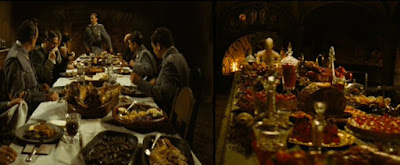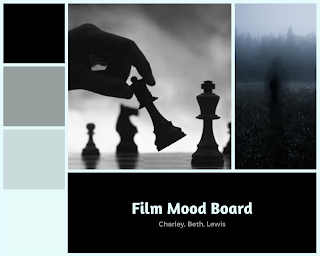4 Short Film Analysis
Wasp
Wasp is a social realist film focused around a single mother of four children reconnecting with a man from her past. With Wasp being a social realist film, there are multiple techniques which are typical of that genre which Arnold applies through the short film. For example, the film has clearly been shot on real locations, without the use of sets or green screen, as a whole doing this makes the short film appear to be more realistic, since it is in an area where people similar to the protagonist may actually live. Because the film is on location, there are many long shots of the surrounding area with the buildings and of the sparse nature around; this establishes a sense of community and mundanity, due to it being a fairly common environment in England. Throughout Wasp, Arnold uses other techniques such as the hand held camera and tracking shots, that are standard to the social realist genre, this may make the audience feel as if they're following along the characters, almost as if they were there. It also gives a sense of movement and chaos like it isn't planned, imitative of real life.
The Gunfighter
This is a western short film about a man entering a saloon and a shoot out occurring. Voice over is used to narrate what is happening in the film, like a stereotypical old western film, however to twist the generic conventions of those films, the characters that are being narrated can hear what the disembodied voice is saying. Because of this conflict happens between the characters in the saloon as the voice unveils the secrets and thoughts of the characters as a way to cause the gunfight at the end. Usually, a 3rd person narration would be non-diegetic, because it would not be a part of the world, but in this case, Kissack has turned the voice diegetic for comedic purposes.
Elephant
Elephant is a film documenting eighteen murders (partially based on real events). The film lacks dialogue and music making it feel empty and sinister, this lack of dialogue in the film may reflect the message Clarke is trying to get across about how the conflict of Northern Ireland happening at the time of release called 'The Troubles' was silently ignored by most people and not talked about. The title refers to a quote from Bernard MacLaverty on the conflict describing it as "the elephant in our living room". There's a series of tracking shots in the film following the victims and murderers as they're walking, this feels almost like a documentary or its as if we, the audience, are just watching the crimes happen, wanting them to stop. Overall it is a story of inaction and gritty realism.
Curfew
This is a heartwarming story of a suicidal man asked to look after his niece for a night. The short film starts and ends in the main character's bathroom, the aesthetic of the room are very contrasting with three main colours, red, black and white. By having the walls as black almost makes it feel like the room is endless darkness, like the character's mental state, and it makes the bath the main focus of the audience. The white of the bath brings out the red of the blood, so it stands out more and is clear to see. All of this makes the scene more visually pleasing. At the beginning of the film there are many close ups of the main character themselves, presenting a feeling of isolation, however as the story progresses we get more two shots of him and his niece as they bond and grow closer, illustrating how he no longer feels totally alone. He also reunites with his sister and has the confidence to monologue about how he always saw her as amazing as he's framed with a medium close-up that becomes a close up after a shot reverse shot back to the sister. While their relationship isn't quite healed, the protagonist got to communicate with her and allow for them to start to get better as a family.
Wasp is a social realist film focused around a single mother of four children reconnecting with a man from her past. With Wasp being a social realist film, there are multiple techniques which are typical of that genre which Arnold applies through the short film. For example, the film has clearly been shot on real locations, without the use of sets or green screen, as a whole doing this makes the short film appear to be more realistic, since it is in an area where people similar to the protagonist may actually live. Because the film is on location, there are many long shots of the surrounding area with the buildings and of the sparse nature around; this establishes a sense of community and mundanity, due to it being a fairly common environment in England. Throughout Wasp, Arnold uses other techniques such as the hand held camera and tracking shots, that are standard to the social realist genre, this may make the audience feel as if they're following along the characters, almost as if they were there. It also gives a sense of movement and chaos like it isn't planned, imitative of real life.
The Gunfighter
This is a western short film about a man entering a saloon and a shoot out occurring. Voice over is used to narrate what is happening in the film, like a stereotypical old western film, however to twist the generic conventions of those films, the characters that are being narrated can hear what the disembodied voice is saying. Because of this conflict happens between the characters in the saloon as the voice unveils the secrets and thoughts of the characters as a way to cause the gunfight at the end. Usually, a 3rd person narration would be non-diegetic, because it would not be a part of the world, but in this case, Kissack has turned the voice diegetic for comedic purposes.
Elephant
Elephant is a film documenting eighteen murders (partially based on real events). The film lacks dialogue and music making it feel empty and sinister, this lack of dialogue in the film may reflect the message Clarke is trying to get across about how the conflict of Northern Ireland happening at the time of release called 'The Troubles' was silently ignored by most people and not talked about. The title refers to a quote from Bernard MacLaverty on the conflict describing it as "the elephant in our living room". There's a series of tracking shots in the film following the victims and murderers as they're walking, this feels almost like a documentary or its as if we, the audience, are just watching the crimes happen, wanting them to stop. Overall it is a story of inaction and gritty realism.
Curfew
This is a heartwarming story of a suicidal man asked to look after his niece for a night. The short film starts and ends in the main character's bathroom, the aesthetic of the room are very contrasting with three main colours, red, black and white. By having the walls as black almost makes it feel like the room is endless darkness, like the character's mental state, and it makes the bath the main focus of the audience. The white of the bath brings out the red of the blood, so it stands out more and is clear to see. All of this makes the scene more visually pleasing. At the beginning of the film there are many close ups of the main character themselves, presenting a feeling of isolation, however as the story progresses we get more two shots of him and his niece as they bond and grow closer, illustrating how he no longer feels totally alone. He also reunites with his sister and has the confidence to monologue about how he always saw her as amazing as he's framed with a medium close-up that becomes a close up after a shot reverse shot back to the sister. While their relationship isn't quite healed, the protagonist got to communicate with her and allow for them to start to get better as a family.


Comments
Post a Comment